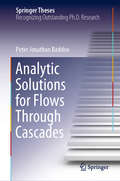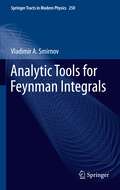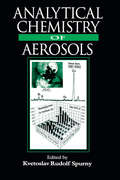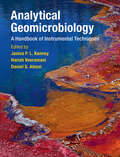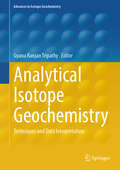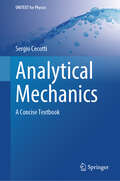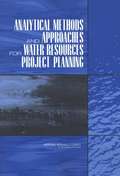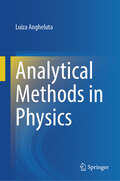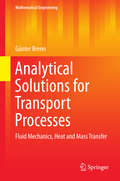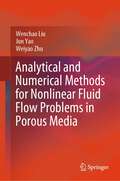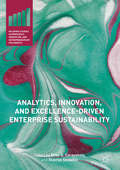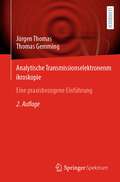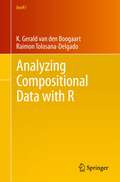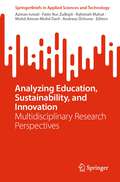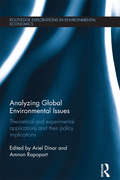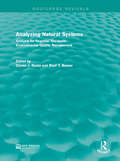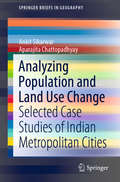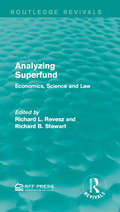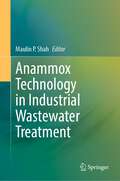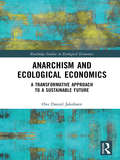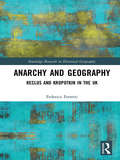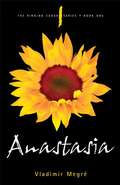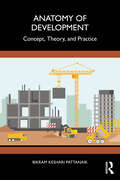- Table View
- List View
Analytic Solutions for Flows Through Cascades (Springer Theses)
by Peter Jonathan BaddooThis thesis is concerned with flows through cascades, i.e. periodic arrays of obstacles. Such geometries are relevant to a range of physical scenarios, chiefly the aerodynamics and aeroacoustics of turbomachinery flows. Despite the fact that turbomachinery is of paramount importance to a number of industries, many of the underlying mechanisms in cascade flows remain opaque. In order to clarify the function of different physical parameters, the author considers six separate problems. For example, he explores the significance of realistic blade geometries in predicting turbomachinery performance, and the possibility that porous blades can achieve noise reductions. In order to solve these challenging problems, the author deploys and indeed develops techniques from across the spectrum of complex analysis: the Wiener–Hopf method, Riemann–Hilbert problems, and the Schottky–Klein prime function all feature prominently. These sophisticated tools are then used to elucidate the underlying mathematical and physical structures present in cascade flows. The ensuing solutions greatly extend previous works and offer new avenues for future research. The results are not of simply academic value but are also useful for aircraft designers seeking to balance aeroacoustic and aerodynamic effects.
Analytic Tools for Feynman Integrals (Springer Tracts in Modern Physics #250)
by Vladimir A. SmirnovThe goal of this book is to describe the most powerful methods for evaluating multiloop Feynman integrals that are currently used in practice. This book supersedes the author's previous Springer book "Evaluating Feynman Integrals" and its textbook version "Feynman Integral Calculus." Since the publication of these two books, powerful new methods have arisen and conventional methods have been improved on in essential ways. A further qualitative change is the fact that most of the methods and the corresponding algorithms have now been implemented in computer codes which are often public. In comparison to the two previous books, three new chapters have been added: One is on sector decomposition, while the second describes a new method by Lee. The third new chapter concerns the asymptotic expansions of Feynman integrals in momenta and masses, which were described in detail in another Springer book, "Applied Asymptotic Expansions in Momenta and Masses," by the author. This chapter describes, on the basis of papers that appeared after the publication of said book, how to algorithmically discover the regions relevant to a given limit within the strategy of expansion by regions. In addition, the chapters on the method of Mellin-Barnes representation and on the method of integration by parts have been substantially rewritten, with an emphasis on the corresponding algorithms and computer codes.
Analytical Chemistry of Aerosols: Science and Technology
by Kvetoslav Rudolf SpurnyUntil the 1980s, researchers studied and measured only the physical properties of aerosols. Since the 80s, however, interest in the physicochemcal properties of aerosols has grown tremendously. Scientists in environmental hygiene, medicine, and toxicology have recognized the importance held by the chemical composition and properties of aerosols and the interactions of inhaled, "bad" aerosols.This book offers the first comprehensive treatment of modern aerosol analytical methods, sampling and separation procedures, and environmental applications, and offers critical reviews of the latest literature. This important field has developed rapidly in the last 15 years, but until now, no book effectively summarized or analyzed the existing research.Analytical Chemistry of Aerosols reviews procedures, techniques, and trends in the measurement and analysis of atmospheric aerosols. With contributions from acknowledged, international experts, the book discusses various methods of bulk analysis, single particle analysis, and the analysis of special aerosol systems, including fibrous and bacterial aerosols.
Analytical Geomicrobiology: A Handbook of Instrumental Techniques
by Kenney Janice P. L. Harish Veeramani Daniel S. AlessiGeomicrobiology is the study of microbes and microbial processes and their role in driving environmental and geological processes at scales ranging from the nano, micron, to meter scale. This growing field has seen major advances in recent years, largely due to the development of new analytical tools and improvements to existing techniques, which allow us to better understand the complex interactions between microbes and their surroundings. In this comprehensive handbook, expert authors outline the state-of-the-art and emerging analytical techniques used in geomicrobiology. Readers are guided through each technique including background theory, sample preparation, standard methodology, data collection and analysis, best practices and common pitfalls, and examples of how and where the technique has been applied. The book provides a practical go-to reference for advanced students, researchers and professional scientists looking to employ techniques commonly used in geomicrobiology.
Analytical Groundwater Mechanics
by Otto D. L. StrackGroundwater mechanics is the study of fluid flow in porous media. Focusing on applications and case studies, this book explains the basic principles of groundwater flow using mathematical expressions to describe a wide range of different aquifer configurations. Emphasis is placed throughout on the importance of developing simplified models that can be solved analytically to provide insight into complex groundwater flow scenarios and to allow better interpretation of the full numerical solution. Focusing first on identifying the important features of a problem, the book explains how to translate practical questions into mathematical form and discusses the interpretation of the results. Illustrated with numerous real-world examples and graphical results, this is an ideal textbook for advanced undergraduate and graduate Earth science, geological engineering, and environmental engineering courses, as well as a useful reference for researchers and professionals.
Analytical Isotope Geochemistry: Techniques and Data Interpretation (Advances in Isotope Geochemistry)
by Gyana Ranjan TripathyIsotopes of radiogenic and non-traditional stable elements have been extensively used for quantitative understanding of earth, planetary, ocean, and climatic processes. More recently, these applications have also been extended to medical, petroleum, forensic, and archaeological sciences. The proposed book aims at providing thorough analytical details for precise (ppm-level) isotopic measurements using state-of-the-art mass spectrometers (e.g., IRMS, TIMS, MC-ICPMS). All essential details on sample handling, chromatographic/solvent-extraction purification, isobaric interferences, spike-sample equilibration, data corrections, and measurement statistics for different isotopes have been reviewed here. It will also provide (i) information on recent technical analytical developments and (ii) &“do's-and-don'ts&” for analyzing isotopic ratios precisely. This book serves as an excellent handbook to set up these systematics with proper scientific rigor in academic and industrial laboratories.
Analytical Mechanics: A Concise Textbook (UNITEXT for Physics)
by Sergio CecottiThis textbook is based on the author's lecture notes held at Qiuzhen College, Tsinghua University, Beijing, renowned for its rapid scientific growth of its excellent students. The book offers a remarkable combination of characteristics that are both exceptional and seemingly contradictory. It is designed to be entirely self-contained, starting from the basics and building a strong foundation in geometric and algebraic tools. Simultaneously, topics are infused with mathematical elegance and profundity, employing contemporary language and techniques. From a physicist's perspective, the content delves deeply into the physical aspects, emphasizing the underlying principles. This book bridges the gap between students and cutting-edge research, with a special focus on symplectic geometry, integrability, and recent developments in the field. It is designed to engage and captivate the reader. A conscious selection of topics ensures a more relevant and contemporary approach compared to traditional textbooks. The book addresses common misconceptions, offering clarity and precision. In its quest for brevity, this book is tailored for a one-semester course, offering a comprehensive and concise resource. The author's dedication is evident throughout this volume, encapsulating these goals within roughly 300 pages.
Analytical Methods And Approaches For Water Resources Project Planning
by Panel On Methods Techniques of Project AnalysisInformation on Analytical Methods And Approaches For Water Resources Project Planning
Analytical Methods in Physics
by Luiza AnghelutaThis textbook is based on lectures for a third-year course on mathematical methods in physics taught in the Department of Physics at the University of Oslo. This textbook contains 26 lectures organized into five topics: i) Complex Analysis, ii) Variational Calculus, iii) Ordinary Differential Equations, iv) Integral Transformations, and v) Partial Differential Equations. For each topic, basic fundamental theorems and mathematical techniques are introduced and applied to solving problems. This resource is intended as concise and well-structured, making it suitable for a one-semester course. It is aimed at second- or third-year undergraduate students with background in mathematics and physical science.
Analytical Solutions for Transport Processes: Fluid Mechanics, Heat and Mass Transfer (Mathematical Engineering)
by Günter BrennThis monograph provides analytical solutions to a number of classical problems in transport processes, i. e. in fluid mechanics, heat and mass transfer. Increasing computing power and efficient numerical methods have increased the importance of computational tools. However, the interpretation of these results is often difficult and the computational results need to be tested against the analytical results. This is why the analytical solutions are of high value. Furthermore, analytical solutions for transport processes provide a much deeper understanding of the physical phenomena of a given process than the corresponding numerical solution. The target audience primarily comprises researcher and practitioners but the book may also be beneficial for graduate students who want to enter the field.
Analytical and Numerical Methods for Nonlinear Fluid Flow Problems in Porous Media
by Weiyao Zhu Jun Yao Wenchao LiuThis book investigates in detail the mathematical methods and computation methods in efficient solution of some open nonlinear seepage flow problems involved in engineering problems. Developed engineering technologies and some relevant practical field applications are also provided. The introduced open nonlinear problems include nonlinear quadratic pressure gradient term problem, compressible gas seepage flow problem and low-velocity non-Darcy seepage flow problem. Studies on these nonlinear seepage flow problems have attracted engineers and scientists from various disciplines, such as geo-energy engineering, civil and environmental engineering, fluid mechanics, applied mathematics and computation. In particular, the book systematically establishes a fundamental theory for a strongly nonlinear problem of low-velocity non-Darcy seepage flow from a new perspective of moving boundary, while emphasizing the usage of mathematical linearization transformation methods and computational methods into the analytical and numerical solution of the strongly nonlinear partial differential equations. Sufficient knowledge of mathematics is always introduced ahead of model solution to assist readers. And the procedure of strict formula deduction in the model solution process is provided in detail. High-solution figures and tables from model solution are rich in the book. Therefore, it is very helpful for the readers to master the nonlinear model solution methods and engineering technologies. The book is intended for upper undergraduate students and graduate students who are interested in engineering technology, fluid mechanics and applied mathematics, researchers and engineers working on geo-energy science and engineering and field applications.
Analytics, Innovation, and Excellence-Driven Enterprise Sustainability (Palgrave Studies in Democracy, Innovation, and Entrepreneurship for Growth)
by Elias G. Carayannis Stavros SindakisThis book offers a unique view of how innovation and competitiveness improve when organizations establish alliances with partners who have strong capabilities and broad social capital, allowing them to create value and growth as well as technological knowledge and legitimacy through new knowledge resources. Organizational intelligence integrates the technology variable into production and business systems, establishing a basis to advance decision-making processes. When strategically integrated, these factors have the power to promote enterprise resilience, robustness, and sustainability. This book provides a unique perspective on how knowledge, information, and data analytics create opportunities and challenges for sustainable enterprise excellence. It also shows how the value of digital technology at both personal and industrial levels leads to new opportunities for creating experiences, processes, and organizational forms that fundamentally reshape organizations.
Analytische Transmissionselektronenmikroskopie: Eine praxisbezogene Einführung
by Jürgen Thomas Thomas GemmingDas Buch wendet sich an alle, egal ob im Studium, in technischen Berufen, oder in der Wissenschaft, die die sich für die analytische Transmissionselektronenmikroskopie interessieren und einen Überblick über diese Methode erhalten möchten. Insbesondere betrifft dies Personen, die an einem Transmissionselektronenmikroskop arbeiten wollen oder müssen, die aber noch keine spezielle elektronenmikroskopische Ausbildung durchlaufen haben. Das Buch basiert auf den Erfahrungen der Autoren bei der Unterrichtung von Studierenden, Promovierenden und in technischen Berufen Tätigen. Der Überblick über die analytische Transmissionselektronenmikroskopie umfasst die Schwerpunkte Optische Abbildung, Elektronenwellen, magnetische Linsen, Abbildungsfehler, Aufbau eines Transmissionselektronenmikroskops, Präparation dünner Proben, Justage des Mikroskops, Elektronenbeugung, Kontrastentstehung, Höchstauflösungselektronenmikroskopie, Rastertransmissionselektronenmikroskopie sowie Analytik mittels energiedispersiver Röntgenspektroskopie und Elektronenenergieverlust-Spektroskopie. Ein mathematischer Anhang erklärt grundlegende Formalismen zur Thematik.
Analyzing Compositional Data with R (Use R!)
by K. Gerald van den Boogaart Raimon Tolosana-DelgadoThis book presents the statistical analysis of compositional data sets, i.e., data in percentages, proportions, concentrations, etc. The subject is covered from its grounding principles to the practical use in descriptive exploratory analysis, robust linear models and advanced multivariate statistical methods, including zeros and missing values, and paying special attention to data visualization and model display issues. Many illustrated examples and code chunks guide the reader into their modeling and interpretation. And, though the book primarily serves as a reference guide for the R package "compositions," it is also a general introductory text on Compositional Data Analysis. Awareness of their special characteristics spread in the Geosciences in the early sixties, but a strategy for properly dealing with them was not available until the works of Aitchison in the eighties. Since then, research has expanded our understanding of their theoretical principles and the potentials and limitations of their interpretation. This is the first comprehensive textbook addressing these issues, as well as their practical implications with regard to software. The book is intended for scientists interested in statistically analyzing their compositional data. The subject enjoys relatively broad awareness in the geosciences and environmental sciences, but the spectrum of recent applications also covers areas like medicine, official statistics, and economics. Readers should be familiar with basic univariate and multivariate statistics. Knowledge of R is recommended but not required, as the book is self-contained.
Analyzing Education, Sustainability, and Innovation: Multidisciplinary Research Perspectives (SpringerBriefs in Applied Sciences and Technology)
by Andreas Öchsner Azman Ismail Mohd Amran Mohd Daril Fatin Nur Zulkipli Rahimah MahatThis book describes a diverse array of studies unravelling the intricate interplay of education, sustainability, and organizational dynamics. From innovative teaching methodologies to sustainability trends and the pandemic's impact, this compendium offers a rich tapestry of insights. This book traverses through a compendium of studies that intricately dissect the synergy between education, sustainability, and organizational dynamics. This book is ideal for academics, practitioners, and curious minds seeking a deeper understanding of these vital contemporary forces.
Analyzing Global Environmental Issues: Theoretical and Experimental Applications and their Policy Implications (Routledge Explorations in Environmental Economics #39)
by Ariel Dinar Amnon RapoportThe existence of environmental dilemmas and political conflicts leads us to appreciate the need for individuals and groups to behave strategically in order to achieve their goals and maintain their wellbeing. Global issues such as climate change, resource depletion, and pollution, as well as revolts and protests against corporations, regimes, and other central authorities, are the result of increased levels of externalities among individuals and nations. These all require policy intervention at international and global levels. This book includes chapters by experts proposing game theoretical solutions and applying experimental design to a variety of social issues related to global and international conflicts over natural resources and the environment. The focus of the book is on applications that have policy implications, relevance and, consequently, could lead to the establishment of policy dialogue. The chapters in the book address issues that are global in nature, such as international environmental agreements over climate change, international water management, common pool resources, public goods, international fisheries, international trade, and collective action, protest, and revolt. The book’s main objective is to illustrate the usefulness of game theory and experimental economics in policy making at multiple levels and for various aspects related to global and international issues. The subject area of this book is already widely taught and researched, but it continues to gain popularity, given growing recognition that the environment and natural resources have become more strategic in human behavior.
Analyzing Natural Systems: Analysis for Regional Residuals-Environmental Quality Management (Routledge Revivals)
by Daniel J. Basta Blair T. BowerThis report was undertaken on local, regional, state and federal levels in the United States to analyse the impact residuals have on environmental quality and to emphasise the need for Residuals- Environmental quality management (REQM). Originally published in 1982, this study brings together information on approaches for analysing natural systems and which factors to consider when choosing an approach. This title will be of interest to students of environmental studies as well as professionals and policy makers.
Analyzing Population and Land Use Change: Selected Case Studies of Indian Metropolitan Cities (SpringerBriefs in Geography)
by Ankit Sikarwar Aparajita ChattopadhyayThis multidisciplinary book discusses and scientifically analyzes issues related to population, land use/cover (LULC) and environmental transformations in the seven most populated cities in India: Delhi, Mumbai, Kolkata, Bangalore, Chennai, Hyderabad and Ahmedabad. To do so, it closely examines and compares the trends in selected population parameters, including total population, total number of households, population density, population growth rate, percent of total population in slums and intercensal net migration over the past two decades. Presenting the changes in various LULC categories (built-up land, forest cover, agricultural land, fallow land and water bodies) using the supervised classification of Landsat TM-5 images, it assesses the impact of population and LULC on the maximum and minimum temperatures and average annual rainfall in these regions. The book is a valuable resource for researchers and academics in the areas of sustainability, population and development, and environmental studies as well as those in NGOs and humanitarian sectors working in the areas of sustainable development and environment.
Analyzing Superfund: Economics, Science and Law (Routledge Revivals)
by Richard B. Stewart Richard L. ReveszOriginally published in 1995, Analyzing Superfund outlines the key issues of the superfund reauthorization debate in the United States. The Superfund law faced criticism for being wasteful, inefficient and expensive. These papers sought to shed light on this argument in relation to clean-up standards, the liability regime, transaction costs and natural resource damage. This title will be of interest to students of Environmental Studies and professionals
Anammox Technology in Industrial Wastewater Treatment
by Maulin P. ShahAmmonia in wastewater causes the eutrophication of water bodies and the subsequent depletion of dissolved oxygen. In addition, certain forms of nitrogen such as ammonia, nitrite, and nitrate are highly toxic to aquatic life. Although there are several biological and physical–chemical techniques for the removal of ammoniacal nitrogen compounds, including air stripping and breakpoint chlorination, which have been widely applied, a microbiological or microbe-based approach is attractive because it is based on sustainable technologies. In this regard, ammonia-oxidizing bacteria have recently gained great interest, specifically in wastewater treatment plants for the removal of ammoniacal nitrogen especially, owing to its relatively low capital cost, eco-friendliness, and high efficiency when compared with conventional cleanup technologies. This book provides specific and advanced knowledge on the microbial ecology of ammonia-oxidizing bacteria and their diversity and functions in the treatment of toxic pollutants present in wastewater. The book thus serves as a valuable resource for engineers, scientists, and managers who require an excellent introductory and advanced knowledge of the field, professionals who are working or interested in the environmental microbiology or bioremediation field, and students learning about environmental biotechnology and microbiology.
Anarchism and Ecological Economics: A Transformative Approach to a Sustainable Future (Routledge Studies in Ecological Economics)
by Ove Daniel JakobsenAnarchism and Ecological Economics: A Transformative Approach to a Sustainable Future explores the idea that anarchism – aimed at creating a society where there is as much freedom in solidarity as possible – may provide an ideal political basis for the goals of ecological economics. It seems clear that it is going to be impossible to solve the problems connected to environmental degradation, climate change, economic crashes and increasing inequality, within the existing paradigm. The anarchist aims of reducing the disparities of rank and income in society and obtaining a high standard of living within environmentally sound ecosystems chime well with the ecological economists’ goal of living within our environmental limits for the betterment of the planet and society. The book refers to the UN’s sustainability development goals, and the goals expressed in the Earth Charter, viewing them through an anarchist’s lens. It argues that in order to establish ecological economics as a radical new economy right for the 21st century, neoliberal economics needs to be replaced. By connecting ecological economics to a solid philosophical tradition such as anarchism, it will be easier for ecological economics to become a far more potent alternative to “green” economic thinking, which is based on, and supports, the dominant political regime. Innovative and challenging, this book will appeal to students and scholars interested in economics and the politics surrounding it.
Anarchy and Geography: Reclus and Kropotkin in the UK (Routledge Research in Historical Geography)
by Federico FerrettiThis book provides a historical account of anarchist geographies in the UK and the implications for current practice. It looks at the works of Frenchman Élisée Reclus (1830–1905) and Russian Pyotr Kropotkin (1842–1921) which were cultivated during their exile in Britain and Ireland. Anarchist geographies have recently gained considerable interest across scholarly disciplines. Many aspects of the international anarchist tradition remain little-known and English-speaking scholarship remains mostly impenetrable to authors. Inspired by approaches in historiography and mobilities, this book links print culture and Reclus and Kropotkin’s spheres in Britain and Ireland. The author draws on primary sources, biographical links and political circles to establish the early networks of anarchist geographies. Their social, cultural and geographical context played a decisive role in the formation and dissemination of anarchist ideas on geographies of social inequalities, anti-colonialism, anti-racism, feminism, civil liberties, animal rights and ‘humane’ or humanistic approaches to socialism. This book will be relevant to anarchist geographers and is recommended supplementary reading for individuals studying historical geography, history, geopolitics and anti-colonialism.
Anastasia (The Ringing Cedars Series #1)
by Vladimir Megré John Woodsworth Leonid SharashkinYou are about to read some of the most shocking revelations to appear in thousands of years of human history - so significant that they are changing the course of our destiny and rocking scientific and religious circles to the core.
Anatomy of Development: Concept, Theory, and Practice
by Bikram PattanaikThis book details the fundamentals of development studies by adopting a multi-disciplinary approach. It presents a balanced mix of economic, social, political, cultural and administrative premises of development and analyzes its theoretical and practical dimensions. It also provides insight into the role of the stakeholders of development in different sectors.The volume provides a holistic understanding of development, effectively demonstrating how it differs from economic growth. Beginning with development theories, paradigms and actors involved in the development process, this book goes on to explain the concepts of development administration, development governance, development planning, development management and development communication. One of the fundamental components of the book is the elucidation of Development Theories – classical, neoclassical, developmental and heterodox theories essential to the discipline of “development”.This book will be useful to undergraduate and postgraduate students, researchers, teachers of development studies, economics, sociology, political science, and public administration. It will also be useful to administrators and development administration officials of state and central governments, planners, policymakers and people working in NGOs, in addition to corporate sector functionaries dealing with corporate social responsibilities and those handling developmental issues and challenges.
Anatomy of a South African Karst Hydrosystem: The Hydrology and Hydrogeology of the Cradle of Humankind World Heritage Site (Cave and Karst Systems of the World)
by Philip J. Hobbs Harrison Pienaar Eddie Van Wyk Yongxin XuThis book combines the results of the research activities in the assessment of water resources environment and an integrated water resource monitoring program to support preservation efforts of the aquatic environment of the Cradle of Humankind (COH), World Heritage Sites. A poor understanding of the surface and groundwater resources of the COH property has precipitated often alarmist reporting in the media regarding the negative impacts associated with various sources of poor quality water. The most notable of these is the acid mine drainage threat to karst ecosystems and fossil sites across the property. These circumstances have generated wide and considerable concern for the preservation of the UNESCO-inscribed fossil sites and integrity of the water resources of the property.
